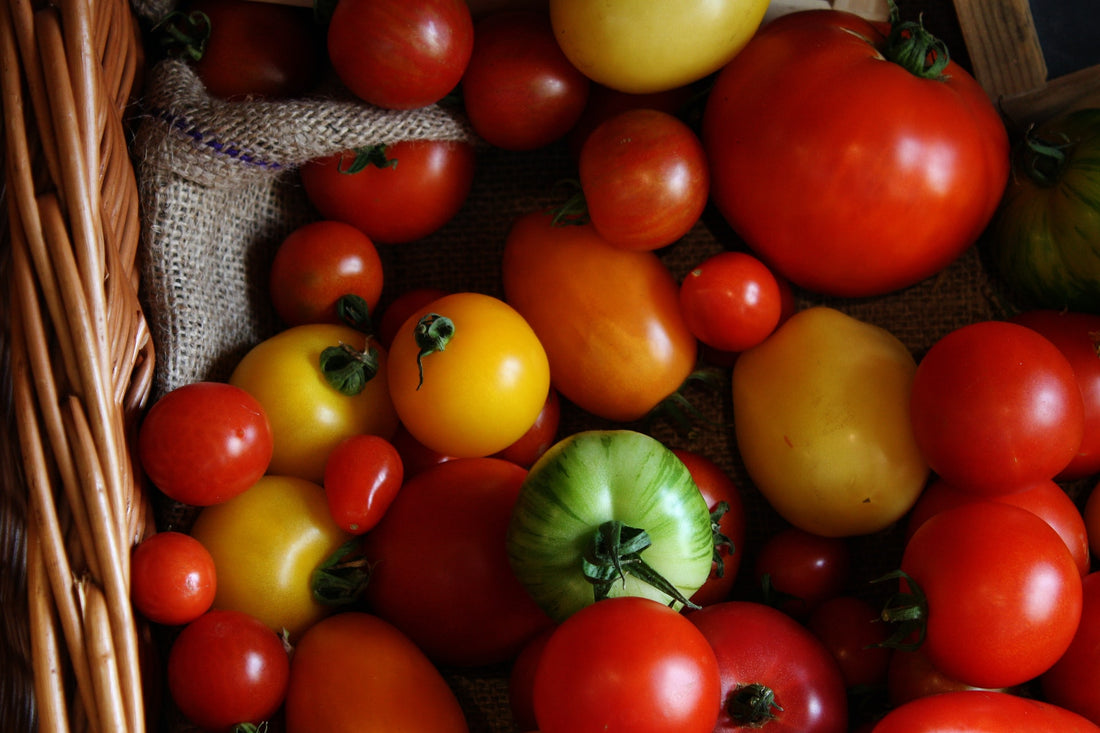Freshly picked tomatoes are a true delight. The juiciness, flavor, and color of home-grown tomatoes are in all ways superior to store-bought options. Luckily, tomatoes are one of the easiest vegetables to grow. They will grow in the ground, in containers, raised beds, and hanging upside down in a basket. All tomatoes need is a good sunny spot, plenty of water, and a little attention.
While the tomato plant itself grows readily in various conditions, it does take a little knowledge and work to produce huge harvests of thick, juicy fruits. Before you plant any tomatoes, make sure you choose the right type and provide it with the keys to success.
When choosing a tomato variety to grow, you'll need to consider type, season, variety, and fruit size. This information is found in the cultivar description on the website or the seed package.
Types of Tomatoes
The varieties available to the home gardener are vast, varied, and versatile. There are literally hundreds of cultivars to choose from, and the one you choose goes a long way towards a successful crop.
First, you need to choose between a determinate or indeterminate type. This classification indicates how the tomato plant grows. Determinate tomato varieties grow to a predetermined height, then stop. All the fruit matures at the same time and must be harvested all at once. Determinate tomato plants are easily caged or staked. They also mature faster than indeterminate ones. A determinate tomato plant is ideal for container growing, small or limited garden spaces, and harvesting for preserving. Dwarf tomatoes are smaller versions of determinate varieties designed specifically for container growing.
Indeterminate tomato varieties don't have a specific height limit; they grow widely and wildly, stretching out vertically and horizontally. If they are not pruned or tended, they are known to turn the tomato patch into a jungle. Some indeterminate tomatoes grow up to 7-8 feet, so don't take this lightly! They must be staked or caged. Indeterminate tomatoes are slower to mature than determinate types, and the fruits ripen over a period of several weeks instead of all at once. The majority of heirloom tomatoes are indeterminate.
Early, Mid, and Late Season
Some tomatoes are ready in 60 days, while others take up to 120 days. Choose tomato varieties that will grow in your climate. If you have a short growing season, 100-day tomatoes may not be a great choice since they won't have enough time to ripen fully.
Slicing, Beefsteak, Plum, Cherry, and Grape
Once you've narrowed down tomato variety options by growth and season, it's time to get to the fun part – choosing a size!
The classic round tomato that is everywhere is a slicing tomato. Slicing tomatoes earn their name because they are easily sliced into rounds for a sandwich. Most slicing tomatoes are large, spherical, and filled with lots of seeds and juice. Beefsteak tomatoes are a popular slicing variety.
The smaller plum tomato is oblong-shaped, with a thick wall and less juice and seeds. Plum tomatoes are meaty, dense, and the preferred choice for canning and making sauces.
The smallest tomatoes are cherry and grape types. Cherry tomatoes are small, completely round, and bite-sized. They are very sweet and juicy, sometimes tasting almost like candy. Grape tomatoes are small and oblong-shaped. They are sweet, but not nearly as much as cherry tomatoes. Grape tomatoes generally are thicker walled, as well, providing a meatier crunch or bite.
Heirlooms vs. Hybrids
Hybrid tomatoes are receiving a lot of attention because of their specially selected characteristics. Generally, tomatoes do not cross-pollinate naturally. A hybrid is created when two different plants are carefully crossbred to create a superior version. Each parent plant provides its best traits, producing a tomato with disease or pest resistance or improved growth rates. While this may seem like the best option for tomato seeds, hybrids come with a considerable downside. Seeds are not true-to-type. This means that any seeds that are saved will not produce the exact same tomato plant. To grow the same tomato, you must purchase seeds from the supplier every year.
Heirloom tomatoes, on the other hand, are quite different. Seeds are easily saved year to year and will produce the same tomato type. The plants usually won't produce exactly uniform fruits or generate the same size crop year to year. Heirlooms are more susceptible to diseases, too. However, heirloom tomatoes are vastly superior in taste, color, size, and quality. Heirloom seeds have been passed on for generations, many even before seed catalogs were readily available to the general public. Friends, families, and neighbors shared the varieties they loved and ensured the survival of the seeds for a hundred or more years. Heirloom seeds tell a story of our heritage and are an essential resource for the future.
Now that you understand the basics of choosing a seed variety, it's time to decide which ones to grow. Pick several to see how they do in your garden. We like to plant at least one beefsteak slicing tomato and one cherry tomato. It's fun to choose one new type to add to the garden every year and discover a whole new kind of tomato!
Coming up Next: How to Grow Tomatoes, A-Z



